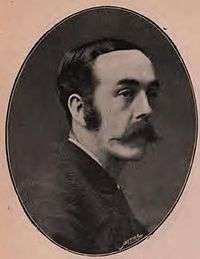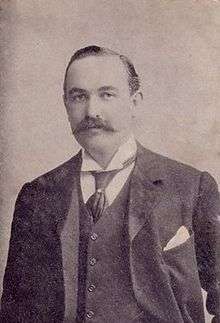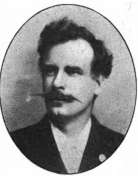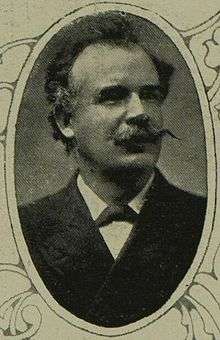Stoke-upon-Trent (UK Parliament constituency)
| Stoke-upon-Trent | |
|---|---|
|
Former Borough constituency for the House of Commons | |
| 1832–1918 | |
| Number of members | two (1832-1885); one (1885-1918) |
| Replaced by | Stoke-on-Trent, Stoke; Stoke-on-Trent, Hanley; Stoke-on-Trent, Burslem |
Stoke-upon-Trent was a parliamentary borough in Staffordshire, which elected two Members of Parliament (MPs) to the House of Commons from 1832 until 1885, and then one member from 1885 until 1918, when the borough was enlarged, renamed Stoke-on-Trent, and split into three single-member constituencies.
History
Stoke-upon-Trent was established as a borough by the Great Reform Act of 1832 to represent the Staffordshire Potteries, one of the most populous urban areas in England which had previously had no separate representation. The new borough consisted of Stoke-upon-Trent and parts of the surrounding towns, and at the time of the Reform Act had a population just over 50,000 (of whom 37,220 were in Stoke parish); in 1867 the boundaries were extended somewhat, to bring in a part of Burslem which had previously been excluded.
In further boundary changes implemented at the 1885 general election, the borough was split into two single-member constituencies, the northern part becoming a separate Hanley borough while the southern part (containing Longton and Fenton as well as Stoke itself) retained the Stoke-upon-Trent name; the new constituency had a population just under 100,000 by the time of the First World War. The industrial interests predominated, with the bulk of the voters being pottery workers or miners, although Stoke was a partly middle-class town; at first an apparently safe Liberal seat, it fell narrowly to the Unionists in both 1895 and 1900, perhaps partly because of discord between miners and potters within the local Liberal party. From 1906 it was held by John Ward as a Lib-Lab MP hostile to the Labour Party, who being from the Navvies' Union could defuse the mutual jealousies of the potters and miners.
By 1918, the pottery towns had been united for municipal purposes in a single Stoke-on-Trent county borough, and the parliamentary boundary changes which came into effect at that year's general election established a parliamentary borough of the same name to replace Stoke-upon-Trent and Hanley, divided into three constituencies: Stoke-on-Trent, Stoke; Stoke-on-Trent, Hanley; and Stoke-on-Trent, Burslem.
Members of Parliament
1832–1885
| Year | First member | First party | Second member | Second party | ||
|---|---|---|---|---|---|---|
| 1832 | Josiah Wedgwood II | Whig | John Davenport | Conservative | ||
| 1835 | Richard Edensor Heathcote | Whig | ||||
| 1836 | Hon. George Anson | Whig | ||||
| 1837 | William Taylor Copeland | Conservative | ||||
| 1841 | John Lewis Ricardo | Whig[1][2] | ||||
| 1852 | Hon. Frederick Leveson-Gower | Whig[3] | ||||
| 1857 | William Taylor Copeland | Conservative | ||||
| 1859 | Liberal | |||||
| 1862 | Henry Grenfell | Liberal | ||||
| 1865 | Alexander Beresford Hope | Conservative | ||||
| February 1868 | George Melly | Liberal | ||||
| November 1868 | William Sargeant Roden | Liberal | ||||
| 1874 | Robert Heath | Conservative | ||||
| 1875 | Edward Kenealy | Independent | ||||
| 1880 | William Woodall | Liberal | Henry Broadhurst | Liberal-Labour | ||
| 1885 | Constituency divided into single-member constituencies, see also Hanley | |||||
1885–1918
| Year | Member | Whip | |
|---|---|---|---|
| 1885 | William Leatham Bright | Liberal | |
| 1890 | George Leveson-Gower | Liberal | |
| 1895 | Douglas Coghill | Liberal Unionist | |
| 1900 | Conservative | ||
| 1906 | John Ward | Liberal | |
| 1918 | Constituency abolished | ||
Election results
Elections in the 1850s
| Party | Candidate | Votes | % | ± | |
|---|---|---|---|---|---|
| Whig | John Lewis Ricardo | 921 | 36.3 | ||
| Whig | Frederick Leveson-Gower | 848 | 33.4 | ||
| Conservative | William Taylor Copeland | 769 | 30.3 | ||
| Majority | 79 | 3.1 | |||
| Turnout | 1,654 (est) | 93.0 (est) | |||
| Registered electors | 3,189 | ||||
| Whig hold | Swing | ||||
| Whig gain from Conservative | Swing | ||||
| Party | Candidate | Votes | % | ± | |
|---|---|---|---|---|---|
| Conservative | William Taylor Copeland | 1,261 | 44.3 | +14.0 | |
| Whig | John Lewis Ricardo | 822 | 28.9 | −7.4 | |
| Whig | Frederick Leveson-Gower | 764 | 26.8 | −6.6 | |
| Majority | 439 | 15.4 | N/A | ||
| Turnout | 2,054 (est) | 97.1 (est) | +4.1 | ||
| Registered electors | 2,115 | ||||
| Conservative gain from Whig | Swing | +14.0 | |||
| Whig hold | Swing | −7.2 | |||
| Party | Candidate | Votes | % | ± | |
|---|---|---|---|---|---|
| Liberal | John Lewis Ricardo | 1,258 | 43.4 | +14.5 | |
| Conservative | William Taylor Copeland | 1,074 | 37.0 | −7.3 | |
| Liberal | Samuel Pope[5][6] | 569 | 19.6 | −7.2 | |
| Turnout | 1,988 (est) | 89.5 (est) | −7.6 | ||
| Registered electors | 2,221 | ||||
| Majority | 184 | 6.3 | N/A | ||
| Liberal hold | Swing | +9.1 | |||
| Majority | 505 | 17.4 | +2.0 | ||
| Conservative hold | Swing | −7.3 | |||
Elections in the 1860s
Ricardo's death caused a by-election.
| Party | Candidate | Votes | % | ± | |
|---|---|---|---|---|---|
| Liberal | Henry Grenfell | 1,089 | 53.4 | +10.0 | |
| Conservative | Alexander Beresford Hope | 918 | 45.0 | +8.0 | |
| Liberal | George Melly | 32 | 1.6 | −18.0 | |
| Majority | 171 | 8.4 | +2.1 | ||
| Turnout | 2,039 | 82.9 | −6.6 | ||
| Registered electors | 2,461 | ||||
| Liberal hold | Swing | +3.0 | |||
| Party | Candidate | Votes | % | ± | |
|---|---|---|---|---|---|
| Conservative | Alexander Beresford Hope | 1,463 | 35.6 | −1.4 | |
| Liberal | Henry Grenfell | 1,373 | 33.4 | −10.0 | |
| Liberal | George Melly | 1,277 | 31.0 | +11.4 | |
| Majority | 90 | 2.2 | −15.2 | ||
| Turnout | 2,788 (est) | 87.4 (est) | −2.1 | ||
| Registered electors | 3,189 | ||||
| Conservative hold | Swing | −1.4 | |||
| Liberal hold | Swing | −4.3 | |||
Beresford Hope resigned in order to contest a by-election at Cambridge University, causing a by-election.
| Party | Candidate | Votes | % | ± | |
|---|---|---|---|---|---|
| Liberal | George Melly | 1,489 | 51.2 | −13.2 | |
| Conservative | Colin Minton Campbell[7] | 1,420 | 48.8 | +13.2 | |
| Majority | 69 | 2.4 | N/A | ||
| Turnout | 2,909 | 91.2 | +3.8 | ||
| Registered electors | 3,189 | ||||
| Liberal gain from Conservative | Swing | −13.2 | |||
| Party | Candidate | Votes | % | ± | |
|---|---|---|---|---|---|
| Liberal | George Melly | Unopposed | |||
| Liberal | William Sargeant Roden | Unopposed | |||
| Registered electors | 16,199 | ||||
| Liberal hold | |||||
| Liberal gain from Conservative | |||||
Elections in the 1870s
| Party | Candidate | Votes | % | ± | |
|---|---|---|---|---|---|
| Liberal | George Melly | 6,700 | 28.6 | N/A | |
| Conservative | Robert Heath | 6,180 | 26.4 | N/A | |
| Liberal | William Sargeant Roden | 5,369 | 22.9 | N/A | |
| Lib-Lab | Alfred Walton[8] | 5,198 | 22.2 | N/A | |
| Turnout | 17,413 (est) | 91.0 (est) | N/A | ||
| Registered electors | 19,129 | ||||
| Majority | 520 | 2.2 | N/A | ||
| Liberal hold | Swing | N/A | |||
| Majority | 811 | 3.5 | N/A | ||
| Conservative gain from Liberal | Swing | N/A | |||
Melly resigned, causing a by-election.
| Party | Candidate | Votes | % | ± | |
|---|---|---|---|---|---|
| Independent | Edward Kenealy | 6,110 | 43.1 | N/A | |
| Lib-Lab | Alfred Walton[8] | 4,168 | 29.4 | +7.2 | |
| Conservative | Harry Davenport | 3,901 | 27.5 | +1.1 | |
| Majority | 1,942 | 13.7 | N/A | ||
| Turnout | 14,179 | 72.5 | −18.5 | ||
| Registered electors | 19,548 | ||||
| Independent gain from Liberal | Swing | N/A | |||
Elections in the 1880s
| Party | Candidate | Votes | % | ± | |
|---|---|---|---|---|---|
| Liberal | William Woodall | 12,130 | 40.8 | −10.7 | |
| Lib-Lab | Henry Broadhurst | 11,379 | 38.3 | +16.1 | |
| Conservative | Robert Heath[9] | 5,126 | 17.2 | −9.2 | |
| Independent | Edward Kenealy | 1,091 | 3.7 | N/A | |
| Majority | 6,253 | 21.0 | +18.8 | ||
| Turnout | 14,863 (est) | 74.4 (est) | −16.6 | ||
| Registered electors | 19,976 | ||||
| Liberal hold | Swing | −7.2 | |||
| Lib-Lab gain from Conservative | Swing | +12.7 | |||
| Party | Candidate | Votes | % | ± | |
|---|---|---|---|---|---|
| Liberal | William Leatham Bright | 4,790 | 63.1 | −16.0 | |
| Conservative | Haden Corser | 2,800 | 36.9 | +19.7 | |
| Majority | 1,990 | 26.2 | +5.2 | ||
| Turnout | 7,590 | 82.4 | +8.0 (est) | ||
| Registered electors | 9,213 | ||||
| Liberal hold | Swing | −17.9 | |||
| Party | Candidate | Votes | % | ± | |
|---|---|---|---|---|---|
| Liberal | William Leatham Bright | 3,255 | 60.9 | -2.2 | |
| Conservative | Haden Corser | 2,093 | 39.1 | +2.2 | |
| Majority | 1,162 | 21.8 | -4.4 | ||
| Turnout | 5,348 | 58.0 | -24.4 | ||
| Registered electors | 9,213 | ||||
| Liberal hold | Swing | -2.2 | |||
Elections in the 1890s
| Party | Candidate | Votes | % | ± | |
|---|---|---|---|---|---|
| Liberal | George Leveson-Gower | 4,157 | 58.7 | −2.2 | |
| Liberal Unionist | William Shepherd Allen | 2,926 | 41.3 | +2.2 | |
| Majority | 1,231 | 17.4 | −4.4 | ||
| Turnout | 7,083 | 73.4 | +15.4 | ||
| Registered electors | 9,649 | ||||
| Liberal hold | Swing | −2.2 | |||
- Caused by Bright's resignation.
| Party | Candidate | Votes | % | ± | |
|---|---|---|---|---|---|
| Liberal | George Leveson-Gower | 4,629 | 61.9 | +1.0 | |
| Conservative | S Waters | 2,846 | 38.1 | −1.0 | |
| Majority | 1,783 | 23.8 | +2.0 | ||
| Turnout | 7,475 | 72.0 | +14.0 | ||
| Registered electors | 10,380 | ||||
| Liberal hold | Swing | +1.0 | |||
Leveson-Gower was appointed Comptroller of the Household, requiring a by-election.
| Party | Candidate | Votes | % | ± | |
|---|---|---|---|---|---|
| Liberal | George Leveson-Gower | Unopposed | |||
| Liberal hold | |||||

| Party | Candidate | Votes | % | ± | |
|---|---|---|---|---|---|
| Liberal Unionist | Douglas Coghill | 4,396 | 51.2 | +13.1 | |
| Liberal | George Leveson-Gower | 4,196 | 48.8 | −13.1 | |
| Majority | 200 | 2.4 | N/A | ||
| Turnout | 8,592 | 77.4 | +5.4 | ||
| Registered electors | 11,107 | ||||
| Liberal Unionist gain from Liberal | Swing | +13.1 | |||
Elections in the 1900s

| Party | Candidate | Votes | % | ± | |
|---|---|---|---|---|---|
| Conservative | Douglas Coghill | 4,932 | 51.0 | −0.2 | |
| Liberal | Godfrey Baring | 4,732 | 49.0 | +0.2 | |
| Majority | 200 | 2.0 | −0.4 | ||
| Turnout | 9,664 | 73.9 | −3.5 | ||
| Registered electors | 13,074 | ||||
| Conservative hold | Swing | −0.2 | |||

| Party | Candidate | Votes | % | ± | |
|---|---|---|---|---|---|
| Lib-Lab | John Ward | 7,660 | 64.1 | +15.1 | |
| Conservative | Douglas Coghill | 4,288 | 35.9 | −15.1 | |
| Majority | 3,372 | 28.2 | N/A | ||
| Turnout | 11,948 | 84.8 | +10.9 | ||
| Registered electors | 14,091 | ||||
| Lib-Lab gain from Conservative | Swing | +15.1 | |||
Elections in the 1910s

| Party | Candidate | Votes | % | ± | |
|---|---|---|---|---|---|
| Lib-Lab | John Ward | 7,688 | 57.4 | −6.7 | |
| Conservative | David Hope Kid | 5,697 | 42.6 | +6.7 | |
| Majority | 1,991 | 14.8 | −13.4 | ||
| Turnout | 13,385 | 88.8 | +4.0 | ||
| Registered electors | 15,079 | ||||
| Lib-Lab hold | Swing | −6.7 | |||
| Party | Candidate | Votes | % | ± | |
|---|---|---|---|---|---|
| Lib-Lab | John Ward | 7,049 | 58.2 | +0.8 | |
| Conservative | Samuel Joyce Thomas | 5,062 | 42.6 | −0.8 | |
| Majority | 1,987 | 16.4 | +1.6 | ||
| Turnout | 12,111 | 80.3 | −8.5 | ||
| Registered electors | 15,079 | ||||
| Lib-Lab hold | Swing | +0.8 | |||
General Election 1914/15:
Another General Election was required to take place before the end of 1915. The political parties had been making preparations for an election to take place and by the July 1914, the following candidates had been selected;
- Liberal-Labour: John Ward
- Unionist: Samuel Joyce Thomas
References
- ↑ "Elections Decided". Manchester Courier and Lancashire General Advertiser. 10 July 1841. p. 6. Retrieved 14 July 2018 – via British Newspaper Archive. (Subscription required (help)).
- ↑ "The Elections". Northern Star and Leeds Advertiser. 3 July 1841. p. 20. Retrieved 14 July 2018 – via British Newspaper Archive. (Subscription required (help)).
- ↑ "The Land and the Charter". Northern Star and Leeds General Advertiser. 10 July 1847. p. 19. Retrieved 14 July 2018 – via British Newspaper Archive. (Subscription required (help)).
- 1 2 3 4 5 6 7 8 9 10 Craig, F. W. S., ed. (1977). British Parliamentary Election Results 1832-1885 (e-book)
|format=requires|url=(help) (1st ed.). London: Macmillan Press. ISBN 978-1-349-02349-3. - ↑ "The Nominations". Morning Post. 30 April 1859. pp. 6–7. Retrieved 14 July 2018 – via British Newspaper Archive. (Subscription required (help)).
- ↑

- ↑ "Stoke-upon-Trent". Bristol Times and Mirror. 12 February 1868. p. 2. Retrieved 18 March 2018 – via British Newspaper Archive. (Subscription required (help)).
- 1 2 "Mr. A. A. Walton". Staffordshire Sentinel. 1 February 1875. p. 4. Retrieved 21 January 2018 – via British Newspaper Archive. (Subscription required (help)).
- ↑ "Polling to-day: Stoke-on-Trent". Yorkshire Post and Leeds Intelligencer. 31 March 1880. p. 6. Retrieved 12 December 2017 – via British Newspaper Archive. (Subscription required (help)).
- 1 2 Craig, F. W. S., ed. (1974). British Parliamentary Election Results: 1885-1918. London: Macmillan Press. p. 196. ISBN 9781349022984.
- 1 2 3 4 5 6 7 The Liberal Year Book, 1907
- ↑ Debrett's House of Commons & Judicial Bench, 1886
- 1 2 3 4 5 6 7 Craig, FWS, ed. (1974). British Parliamentary Election Results: 1885-1918. London: Macmillan Press. ISBN 9781349022984.
- ↑ Debrett's House of Commons & Judicial Bench, 1901
- ↑ Debrett's House of Commons & Judicial Bench, 1901
- ↑ Debrett's House of Commons & Judicial Bench, 1916
- ↑ Debrett's House of Commons & Judicial Bench, 1916
Further reading
- The Constitutional Year Book for 1913 (London: National Union of Conservative and Unionist Associations, 1913)
- F W S Craig, "British Parliamentary Election Results 1832-1885" (2nd edition, Aldershot: Parliamentary Research Services, 1989)
- Michael Kinnear, The British Voter (London: BH Batsford, Ltd, 1968)
- Henry Pelling, Social Geography of British Elections 1885-1910 (London: Macmillan, 1967)
- J Holladay Philbin, Parliamentary Representation 1832 - England and Wales (New Haven: Yale University Press, 1965)
- Frederic A Youngs, jr, Guide to the Local Administrative Units of England, Vol II (London: Royal Historical Society, 1991)
- Leigh Rayment's Historical List of MPs – Constituencies beginning with "S" (part 5)